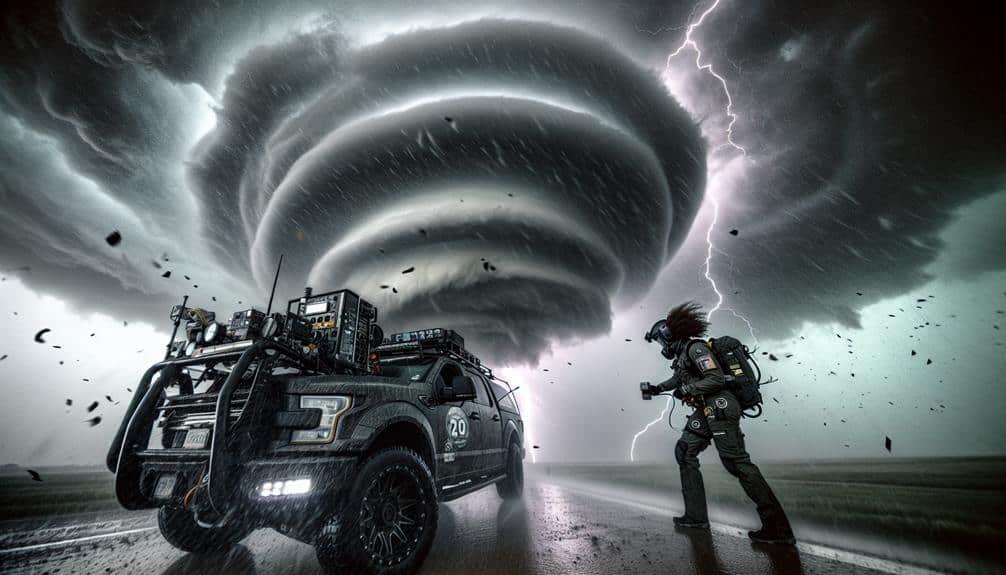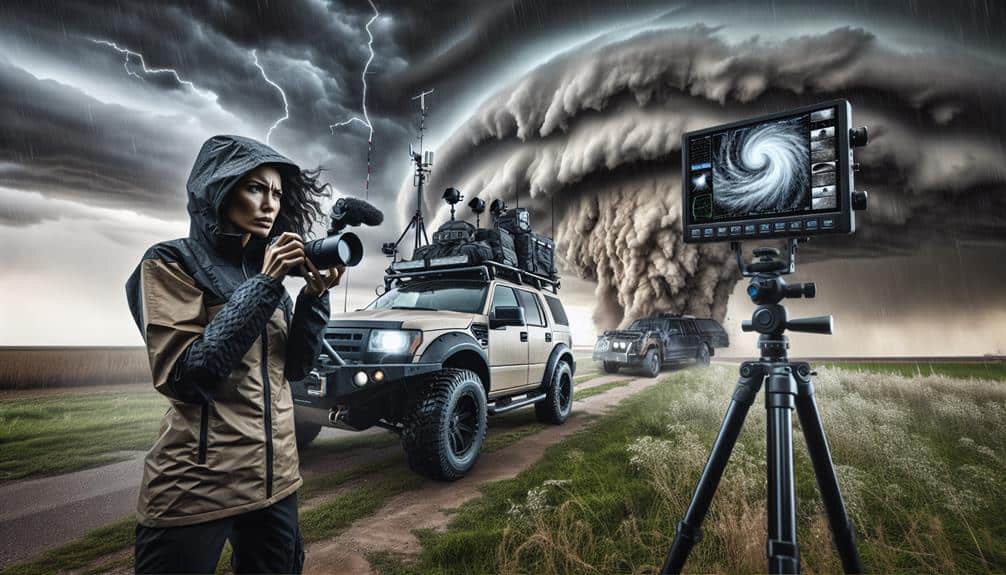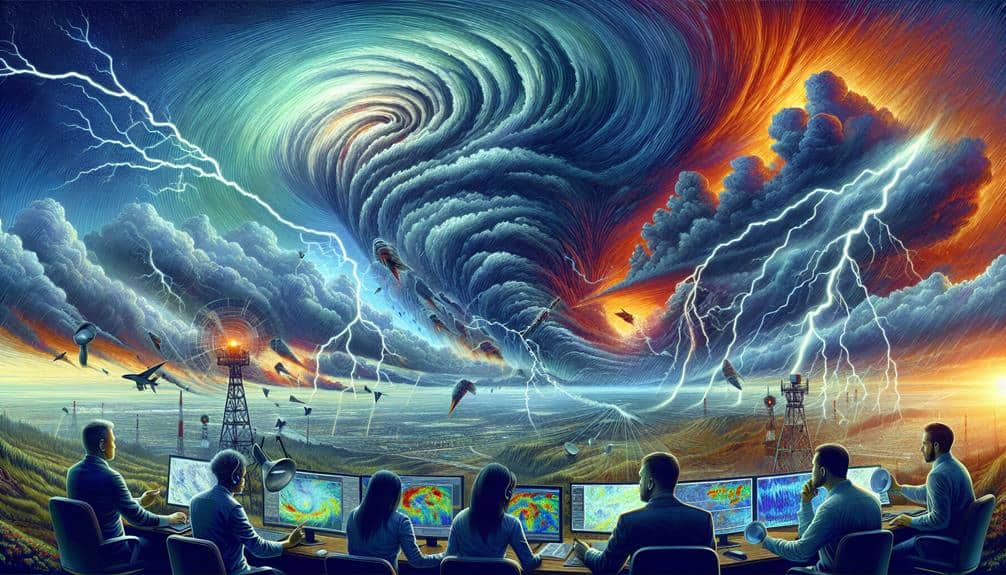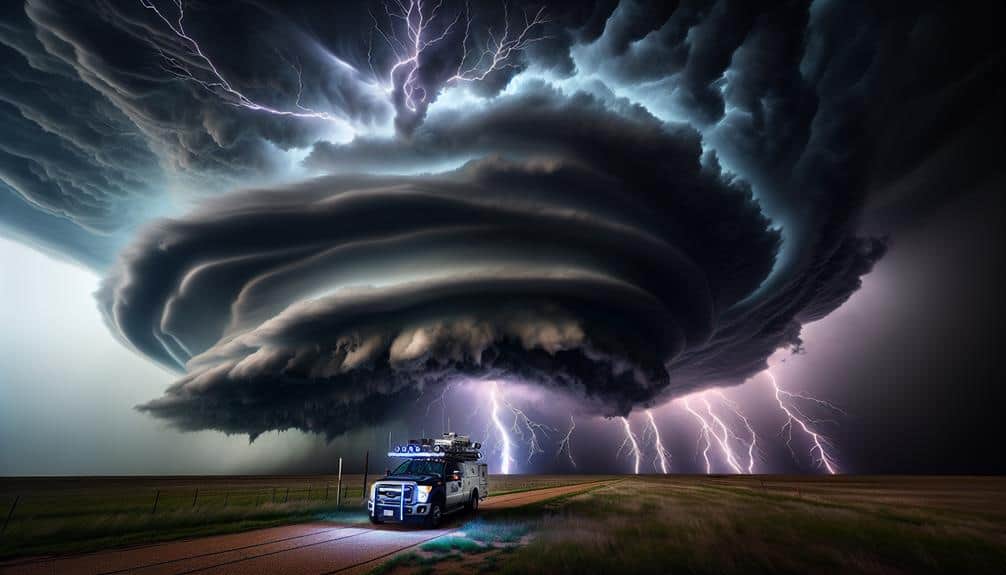When we engage in close-up supercell storm chasing, we confront several significant risks that demand thorough preparation and caution. We face extreme weather conditions with wind speeds over 100 mph and large hailstones exceeding 2 inches. Limited visibility due to heavy rainfall and debris complicates navigation. Dangerous driving situations result from 70% reduced visibility and hazardous road conditions. Unpredictable storm paths, influenced by wind shear and terrain, necessitate robust safety protocols. Finally, we must address health and safety hazards by adhering to protocols and using advanced protective equipment. By understanding these risks, we can improve our mitigation strategies.
Key Points
- Exposure to powerful wind gusts exceeding 100 mph can destabilize vehicles and endanger lives.
- Large hailstones over 2 inches in diameter can cause severe damage to vehicles and injuries.
- Limited visibility due to heavy rainfall and debris complicates navigation and increases collision risks.
- Unpredictable storm paths influenced by wind shear and terrain demand constant vigilance and rapid adjustments.
Extreme Weather Conditions
When we chase supercell storms, we often encounter extreme weather conditions characterized by high wind speeds, large hail, and intense lightning activity. These phenomena create a unique environment for storm photography, but they also require a high level of emergency preparedness.
Data indicate that wind speeds in supercells can exceed 100 mph, which not only impacts our mobility but also poses significant risks to our equipment. Large hailstones, often measuring over 2 inches in diameter, can cause severe damage to vehicles and photographic gear. We need to implement stringent emergency preparedness protocols to protect ourselves and our assets.
Lightning activity within supercell storms is intense, with strike rates often surpassing 50 strikes per minute. This calls for constant vigilance and real-time data monitoring to make sure we remain at a safe distance.
While capturing the raw power of these storms through storm photography offers unparalleled freedom and exhilaration, it's crucial to balance this with safety measures. Our vehicles are equipped with reinforced glass and hail guards, and we keep emergency kits with first-aid supplies, GPS devices, and communication tools to mitigate any potential threats.
Limited Visibility
Moving through supercell storms often presents substantial challenges due to severely limited visibility caused by heavy rainfall, dust, and debris. As storm chasers, we encounter visual impairment that greatly hampers our ability to assess the environment effectively. This reduced awareness leads to increased risk, making it essential to understand and mitigate these limitations.
Visibility issues in supercell storms can stem from multiple factors, often occurring simultaneously:
- Heavy Rainfall: Intense downpours can reduce visibility to just a few feet, making it nearly impossible to see approaching hazards.
- Dust and Debris: Strong winds lift dust and debris, creating a cloud that obscures our vision and poses direct safety concerns.
Each of these factors contributes to a scenario where our visual impairment directly correlates with increased danger.
Modern technology, such as radar and GPS, can aid in situational awareness, but they can't entirely eliminate the risks posed by limited visibility. We must remain vigilant and adaptable, constantly updating our strategies to maintain safety in these unpredictable conditions.
Dangerous Driving Situations
Our struggle with limited visibility is compounded by the hazardous driving conditions that supercell storms create, demanding precise maneuvering and constant vigilance. The intense rainfall, hail, and high winds typical of these storms can obscure our view and make roads treacherous. Statistically, heavy precipitation reduces visibility by 70%, and hydroplaning risks increase by 35%.
We must anticipate sudden road closures and detours, often with little advance warning, which can disrupt our planned routes and force us into unfamiliar territory. Navigating under these circumstances requires continual assessment of road conditions and advanced driving skills. For instance, large hailstones, sometimes exceeding 2 inches in diameter, can inflict severe vehicle damage, necessitating immediate repairs. This damage isn't just superficial; it can impair critical systems like windshields and wipers, reducing our ability to see and react swiftly.
Moreover, supercell storms can generate powerful wind gusts over 70 mph, challenging our vehicle's stability. We must remain acutely aware of the road surface, as debris and downed power lines can obstruct our path. By maintaining a high level of situational awareness and readiness for mechanical contingencies, we enhance our ability to continue chasing while prioritizing safety and operational efficiency.
Unpredictable Storm Paths
Understanding the erratic nature of supercell storm paths is crucial for effective storm chasing and safety management. Supercells, characterized by their rotating updrafts, can change direction unexpectedly, making it difficult to forecast their precise trajectory. This unpredictability increases the risk of storm damage, potentially catching us off guard, and necessitating robust safety protocols.
In our chase strategy, we need to take into account various factors that influence a supercell's path:
- Wind Shear: Variations in wind speed and direction at different altitudes can quickly alter a storm's path.
- Terrain: Mountains, valleys, and other geographical features can deflect and redirect the storm.
Advanced meteorological tools like Doppler radar and satellite imagery can provide real-time data, but even these technologies have limitations. The inherent chaos in atmospheric dynamics means we must continually update our strategies.
By adhering to stringent safety protocols, such as maintaining a safe distance and having multiple exit routes, we can mitigate the risks associated with the sudden changes in storm paths.
Ultimately, our freedom to chase these natural phenomena comes with the responsibility to respect their power and unpredictability.
Health and Safety Hazards

Health and safety hazards in supercell storm chasing require strict adherence to established protocols and the use of advanced protective equipment. We can't emphasize enough the importance of wearing helmets, harnesses, and reinforced clothing to protect against flying debris and extreme weather conditions.
Additionally, utilizing GPS tracking systems and real-time weather data helps us maintain situational awareness and avoid the core of the storm.
Physical exhaustion is a significant concern during these high-adrenaline pursuits. Operating on minimal sleep while maneuvering through rough terrain and unpredictable weather can severely impair our reflexes and decision-making skills. Adopting a structured schedule with mandatory rest periods is essential to mitigate this risk.
Also, maintaining proper hydration and nutrition levels supports sustained physical endurance.
Mental stress, another crucial factor, arises from constant exposure to life-threatening situations and the pressure to capture valuable data. We must employ stress management techniques such as mindfulness practices and team debriefings to maintain psychological resilience.
Regular mental health check-ins and support systems are vital to address any anxiety or trauma experienced during storm chasing.
Frequently Asked Questions
What Equipment Is Essential for Storm Chasing?
For storm chasing, we need essential gear like weather radar, GPS, and durable vehicles. Reliable communication methods, such as satellite phones and radios, guarantee constant updates and coordination. These tools offer us both safety and freedom.
How Can You Maintain Communication During a Supercell Chase?
To maintain communication during a supercell chase, we use satellite phones and two-way radios. These tools are essential for safety precautions and emergency protocols, ensuring we stay connected and respond swiftly to dynamic weather changes.
Are There Specific Permits Required for Storm Chasing?
Ah, the joyous bureaucracy! Yes, permit requirements may exist, varying by region. Safety precautions aren't optional; they're our best buddies. Seriously, check local regulations before storm chasing and confirm all safety measures are in place.
What Resources Are Available for Learning About Storm Chasing?
We can enhance our storm chasing knowledge through field guides and workshops. Online forums and webinars also provide valuable insights and real-time data. These resources empower us, offering the freedom to pursue our passion safely and effectively.
How Can You Document a Storm Chase Effectively?
Imagine capturing a wild stallion: we need precise photo composition and storm footage. We'll use time lapse and storm photography techniques to document each tempest's beauty, ensuring high-quality data for our analytical review.


